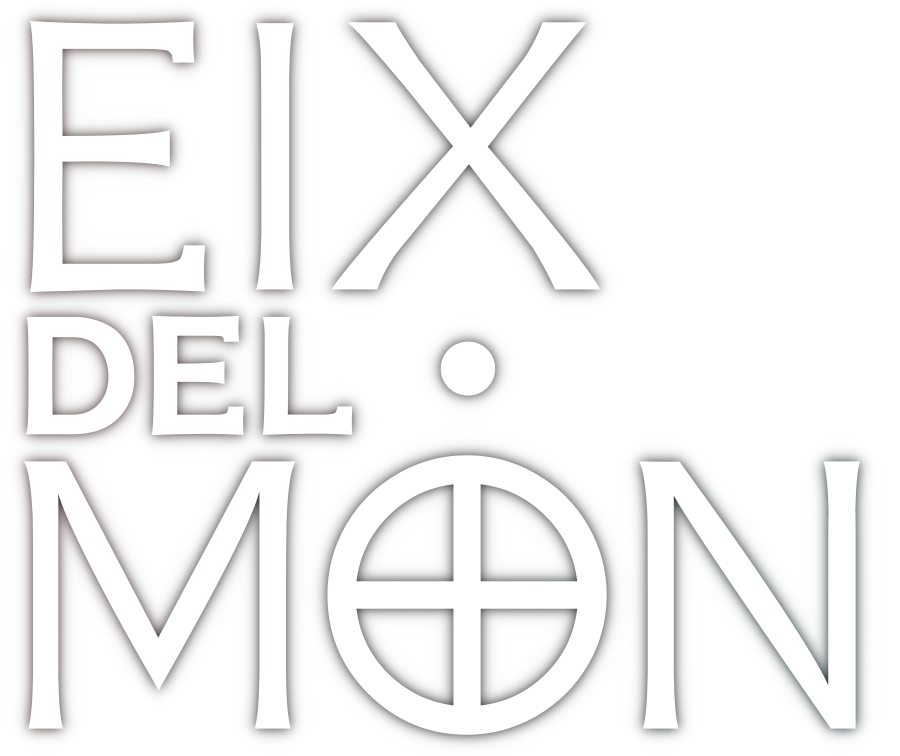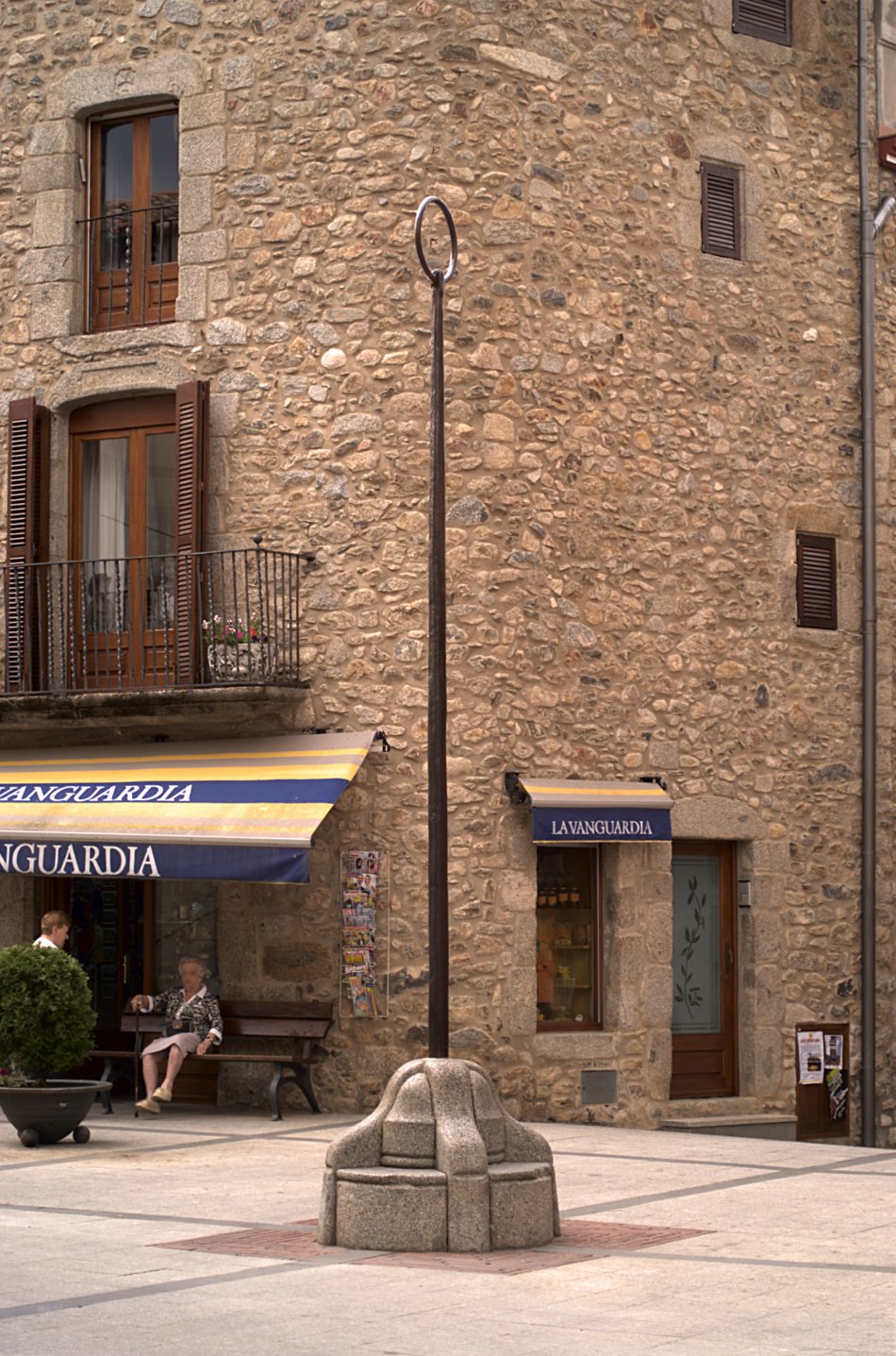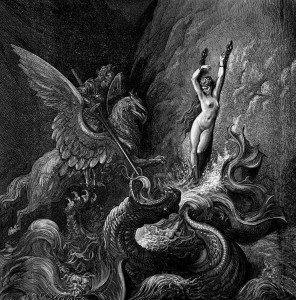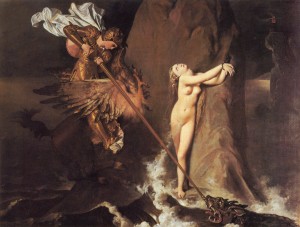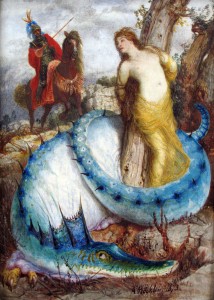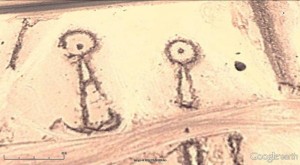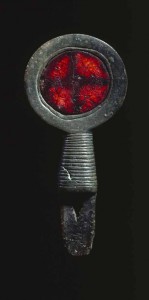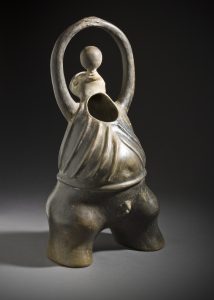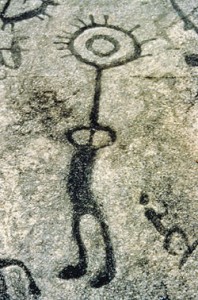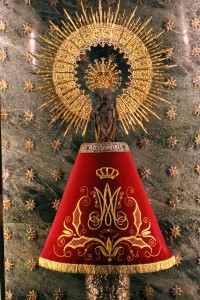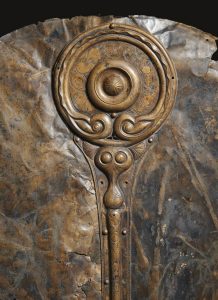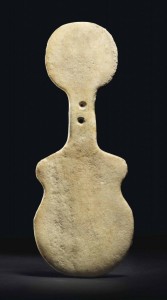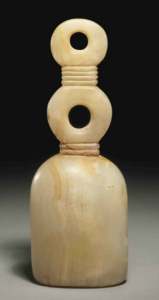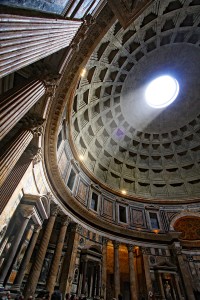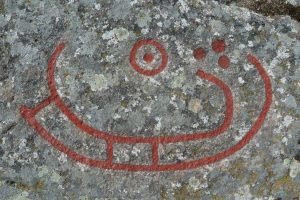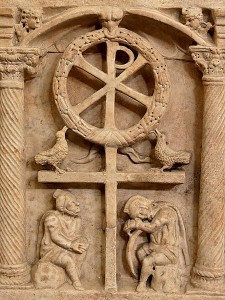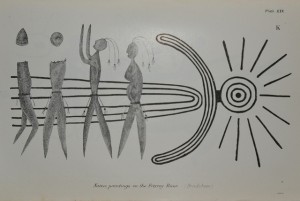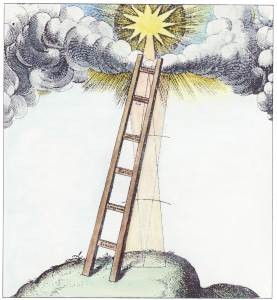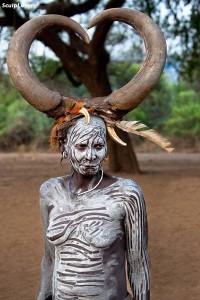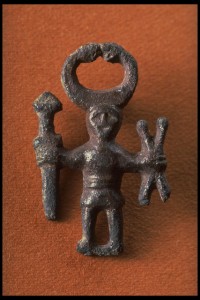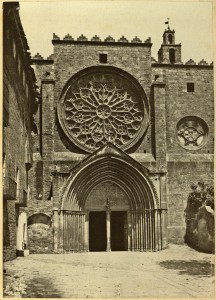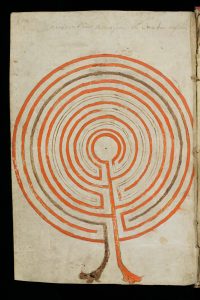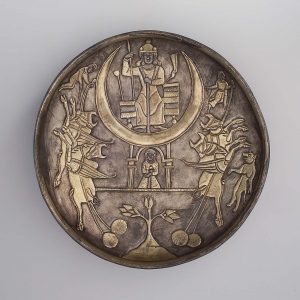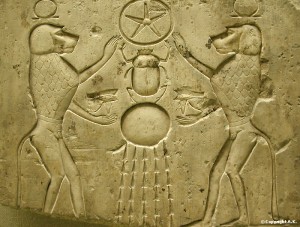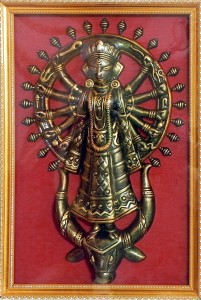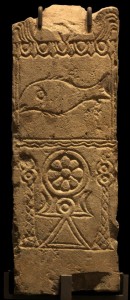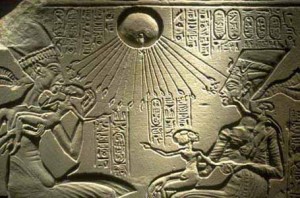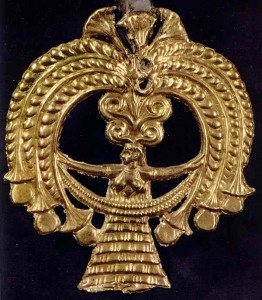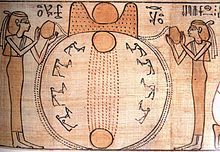La Maça d’en Rotllan (Roland’s Club), Plaça de la Vila, Maçanet de Cabrenys (Alt Empordà, Girona, Catalunya, Espanya). CC BY-SA 3.0 by via Wikimedia Commons.
It is a long iron stick crowned with a ring located in Maçanet de Cabrenys, Spain. The monument, which is 4 m high and weighs about 200 kg, might have been brought from a nearby church, or could have been a former key to open the village’s walls, depending on the source. It was placed there on 1834.
There are several legends regarding this club related to Roland (Rotllan in Catalan), the military leader who fought alongside Charlemagne in the 8th century, and who became a legendary character for several centuries in medieval Europe literature. One of the local legends tells a story in which after defeating the Saracens, on his way to France, Roland threw the club from Céret’s Pont du Diable (Devil’s Bridge, some 12 km away across the mountains) to its current location, while saying:
Allí on la vara caurà,
Maçanet de Cabrenys serà.There where the club falls,
Maçanet de Cabrenys shall be.
-
![[PDF]](https://www.eixdelmon.com/wp-content/plugins/papercite/img/pdf.png) L. Ariosto, Orlando Furioso, Oxford University Press, 1823.
L. Ariosto, Orlando Furioso, Oxford University Press, 1823.
[Bibtex]@Book{orlandofurioso07ariogoog, author = {Ariosto, Lodovico}, title = {Orlando Furioso}, year = {1823}, publisher = {Oxford University Press}, url = {http://www.archive.org/details/orlandofurioso07ariogoog}, abstract = {https://en.wikipedia.org/wiki/Orlando_Furioso Orlando Furioso (Italian: [orˈlando fuˈrjoːzo; -oːso]; The Frenzy of Orlando, more literally Raging Roland; in Italian furioso is seldom capitalized) is an Italian epic poem by Ludovico Ariosto which has exerted a wide influence on later culture. The earliest version appeared in 1516, although the poem was not published in its complete form until 1532. Orlando Furioso is a continuation of Matteo Maria Boiardo's unfinished romance Orlando Innamorato ("Orlando in Love", published posthumously in 1495). In its historical setting and characters, it shares some features with the Old French Chanson de Roland of the eleventh century, which tells of the death of Roland. Orlando is the Christian knight known in French (and subsequently English) as Roland. The action takes place against the background of the war between Charlemagne's Christian paladins and the Saracen army that has invaded Europe and is attempting to overthrow the Christian empire. The poem is about war and love and the romantic ideal of chivalry. It mixes realism and fantasy, humor and tragedy.[1] The stage is the entire world, plus a trip to the moon. The large cast of characters features Christians and Saracens, soldiers and sorcerers, and fantastic creatures including a gigantic sea monster called the orc and a flying horse called the hippogriff. Many themes are interwoven in its complicated episodic structure, but the most important are the paladin Orlando's unrequited love for the pagan princess Angelica, which drives him mad; the love between the female Christian warrior Bradamante and the Saracen Ruggiero, who are supposed to be the ancestors of Ariosto's patrons, the d'Este family of Ferrara; and the war between Christian and Infidel.[2] The poem is divided into forty-six cantos, each containing a variable number of eight-line stanzas in ottava rima (a rhyme scheme of abababcc). Ottava rima had been used in previous Italian romantic epics, including Luigi Pulci's Morgante and Boiardo's Orlando Innamorato. Ariosto's work is 38,736 lines long in total, making it one of the longest poems in European literature.[3] The action of Orlando Furioso takes place against the background of the war between the Christian emperor Charlemagne and the Saracen King of Africa, Agramante, who has invaded Europe to avenge the death of his father Traiano. Agramante and his allies – who include Marsilio, the King of Spain, and the boastful warrior Rodomonte – besiege Charlemagne in Paris. Meanwhile, Orlando, Charlemagne's most famous paladin, has been tempted to forget his duty to protect the emperor through his love for the pagan princess Angelica. At the beginning of the poem, Angelica escapes from the castle of the Bavarian Duke Namo, and Orlando sets off in pursuit. The two meet with various adventures until Angelica saves a wounded Saracen knight, Medoro, falls in love, and elopes with him to Cathay. When Orlando learns the truth, he goes mad with despair and rampages through Europe and Africa destroying everything in his path. The English knight Astolfo journeys to Ethiopia on the hippogriff to find a cure for Orlando's madness. He flies up in Elijah's flaming chariot to the moon, where everything lost on earth is to be found, including Orlando's wits. He brings them back in a bottle and makes Orlando sniff them, thus restoring him to sanity. (At the same time Orlando falls out of love with Angelica, as the author explains that love is itself a form of insanity.) Orlando joins with Brandimart and Oliver to fight Agramante, Sobrino and Gradasso on the island of Lampedusa. There Orlando kills King Agramante. Another important plotline involves the love between the female Christian warrior Bradamante and the Saracen Ruggiero. They too have to endure many vicissitudes. Ruggiero is taken captive by the sorceress Alcina and has to be freed from her magic island. He also has to avoid the enchantments of his foster father, the wizard Atlante, who does not want him to fight. Finally, Ruggiero converts to Christianity and marries Bradamante. Rodomonte appears at the wedding feast and accuses him of being a traitor to the Saracen cause, and the poem ends with Ruggiero slaying Rodomonte in single combat. Ruggiero and Bradamante are the ancestors of the House of Este, Ariosto's patrons, whose genealogy he gives at length in canto 3 of the poem. The epic contains many other characters, including Orlando's cousin, the paladin Rinaldo, who is also in love with Angelica; the thief Brunello; the Saracen Ferraù; Sacripante, King of Circassia and a leading Saracen knight; and the tragic heroine Isabella.}, comment = {Published 1974 Topics Roland (Legendary character) Identifier orlandofurioso07ariogoog Scanner google Mediatype texts Translator William Stewart Rose Identifier-access http://www.archive.org/details/orlandofurioso07ariogoog Oclc-id 1001886 Scandate 20060130 Copyright-region US Identifier-ark ark:/13960/t72v2jc08 Imagecount 241 Source http://books.google.com/books?id=fDgj4tCoQL0C&oe=UTF-8 Lccn 74174554 Ocr ABBYY FineReader 8.0 SHOW LESS Book digitized by Google from the library of the New York Public Library and uploaded to the Internet Archive by user tpb. Volume 1 Publisher London, New York, Oxford University Press Year 1823 Pages 241 Possible copyright status NOT_IN_COPYRIGHT Language English; Italian Digitizing sponsor Google Book from the collections of New York Public Library Collection americana}, file = {orlandofurioso07ariogoog.pdf:media/trismegisto/Vitamin/Documents/Bibliography/orlandofurioso07ariogoog.pdf:PDF}, keywords = {roland,perseus,andromeda}, timestamp = {2016-07-28}, } - G. Martín i Roig, L’Empordà Fantàstic. Llegendes, Farell Editors, 2004.
[Bibtex]@Book{martiniroigemporda2004, author = {Martín i Roig, Gabriel}, title = {L'Empordà Fantàstic. Llegendes}, year = {2004}, date = {2004-06-15}, publisher = {Farell Editors}, isbn = {8495695316}, pages = {128}, url = {https://www.amazon.es/LEmpord%C3%A0-fant%C3%A0stic-Llegendes-Popular/dp/8495695316/ref=sr_1_1?ie=UTF8&qid=1472754768&sr=8-1&keywords=L%27empord%C3%A0+Fant%C3%A0stic}, urldate = {2016-09-01}, abstract = {Emplaçat en el sector septentrional de la costa catalana, l’Empordà és un territori relativament petit, un paradís paisatgístic i cultural, que gaudeix d’una climatologia afortunada. Presenta una diversitat de llocs, contrades i paisatges enriquits i banyats per una generosa llum que en les diferents estacions de l’any dóna a la terra una bellesa singular i extraordinària. La petita, però real, història de cada poble és aquella que durant generacions s’ha anat transmetent per via oral, per tradició secular, i que l’han viscuda intensament els habitants de cada lloc. Són els fets, els costums, les llegendes les que donen a conèixer un poble en la seva manera de ser, en la seva mentalitat. En aquest llibre hi trobareu un recull de llegendes de caire fantàstic.}, keywords = {empordà,legends,catalonia}, owner = {trismegisto}, timestamp = {2016-09-01}, }
The legendary Roland appears as a giant in many local Catalan traditions. It is remarkable that the foundational myth of a village includes a stick with a ring on top of it.
The legend was developed considerably during the Italian Renaissance. Ariosto’s Orlando Furioso appears here with several illustrations. I have added as well some “ring on a pillar” as well:
